Colormaps¶
ProPlot defines colormaps as color palettes that sample some
continuous function between two end colors. Colormaps are generally used
to encode data values on a pseudo-third dimension. They are are implemented
with the LinearSegmentedColormap and
PerceptuallyUniformColormap classes, which are
subclassed from
matplotlib.colors.LinearSegmentedColormap.
ProPlot adds several features to help you use colormaps effectively in your figures. This section documents the new registered colormaps, explains how to make and modify colormaps, and shows how to apply them to your plots.
Included colormaps¶
On import, ProPlot registers a few sample
perceptually uniform colormaps, plus several
colormaps from other online data viz projects. Use
show_cmaps to generate a table of registered maps. The
figure is broken down into the following sections:
“User” colormaps, i.e. colormaps saved to your
~/.proplot/cmapsfolder. You make new colormaps and add them to this folder using theColormapconstructor function.Matplotlib and seaborn original colormaps.
ProPlot original perceptually uniform colormaps.
The cmOcean colormaps, designed for oceanographic data but useful for everyone.
Fabio Crameri’s “scientific colour maps”.
Cynthia Brewer’s ColorBrewer colormaps, included with matplotlib by default.
Colormaps from the SciVisColor project. There are so many of these because they are intended to be merged into more complex colormaps.
ProPlot removes some default matplotlib colormaps with erratic color transitions.
Note
Colormap and color cycle identification is more flexible in ProPlot. The names
are are case-insensitive (e.g., 'Viridis', 'viridis', and 'ViRiDiS'
are equivalent), diverging colormap names can be specified in their “reversed”
form (e.g., 'BuRd' is equivalent to 'RdBu_r'), and appending '_r'
or '_s' to any colormap name will return a
reversed or
shifted version of the colormap
or color cycle. See ColormapDatabase for more info.
[1]:
import proplot as pplt
fig, axs = pplt.show_cmaps()

Perceptually uniform colormaps¶
ProPlot’s custom colormaps are instances of the
PerceptuallyUniformColormap class. These colormaps
generate colors by interpolating between coordinates in any of the
following three colorspaces:
HCL (a.k.a. CIE LChuv): A purely perceptually uniform colorspace, where colors are broken down into “hue” (color, range 0-360), “chroma” (saturation, range 0-100), and “luminance” (brightness, range 0-100). This space is difficult to work with due to impossible colors – colors that, when translated back from HCL to RGB, result in RGB channels greater than
1.HPL (a.k.a. HPLuv): Hue and luminance are identical to HCL, but 100 saturation is set to the minimum maximum saturation across all hues for a given luminance. HPL restricts you to soft pastel colors, but is closer to HCL in terms of uniformity.
HSL (a.k.a. HSLuv): Hue and luminance are identical to HCL, but 100 saturation is set to the maximum saturation for a given hue and luminance. HSL gives you access to the entire RGB colorspace, but often results in sharp jumps in chroma.
The colorspace used by each PerceptuallyUniformColormap
is set with the space keyword arg. To plot arbitrary cross-sections of
these colorspaces, use show_colorspaces (the black
regions represent impossible colors). To see how colormaps vary with
respect to each channel, use show_channels. Some examples
are shown below.
In theory, “uniform” colormaps should have straight lines in hue, chroma,
and luminance (second figure, top row). In practice, this is
difficult to accomplish due to impossible colors. Matplotlib and seaborn’s
'magma' and 'Rocket' colormaps are fairly linear with respect to
hue and luminance, but not chroma. ProPlot’s 'Fire' is linear in hue,
luminance, and HSL saturation (bottom left), while 'Dusk' is linear
in hue, luminance, and HPL saturation (bottom right).
[2]:
# Colorspace demo
import proplot as pplt
fig, axs = pplt.show_colorspaces(refwidth=1.6, luminance=50)
fig, axs = pplt.show_colorspaces(refwidth=1.6, saturation=60)
fig, axs = pplt.show_colorspaces(refwidth=1.6, hue=0)
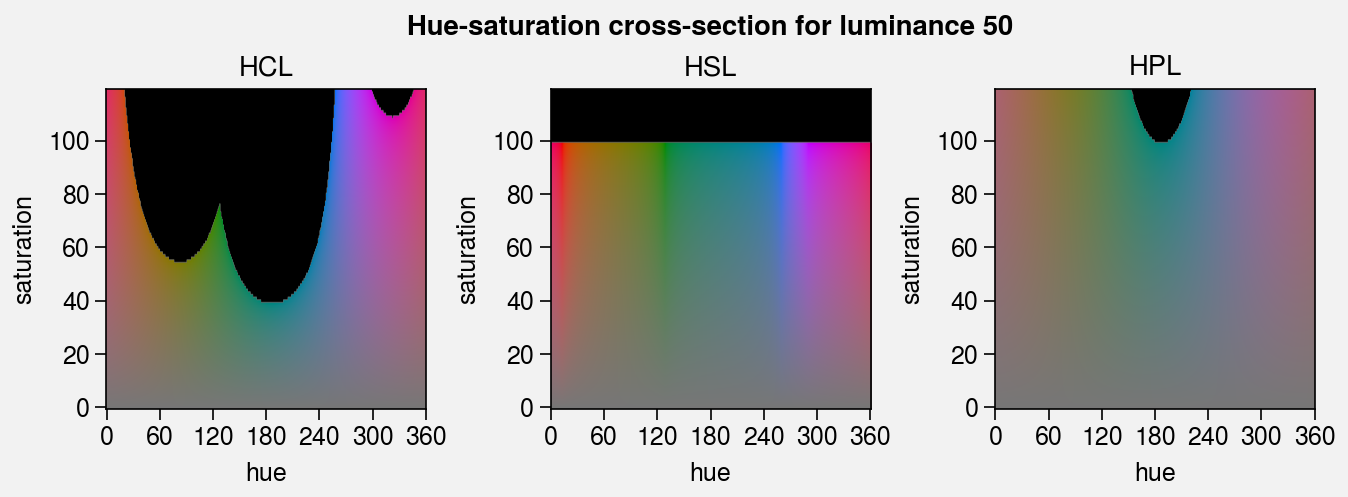
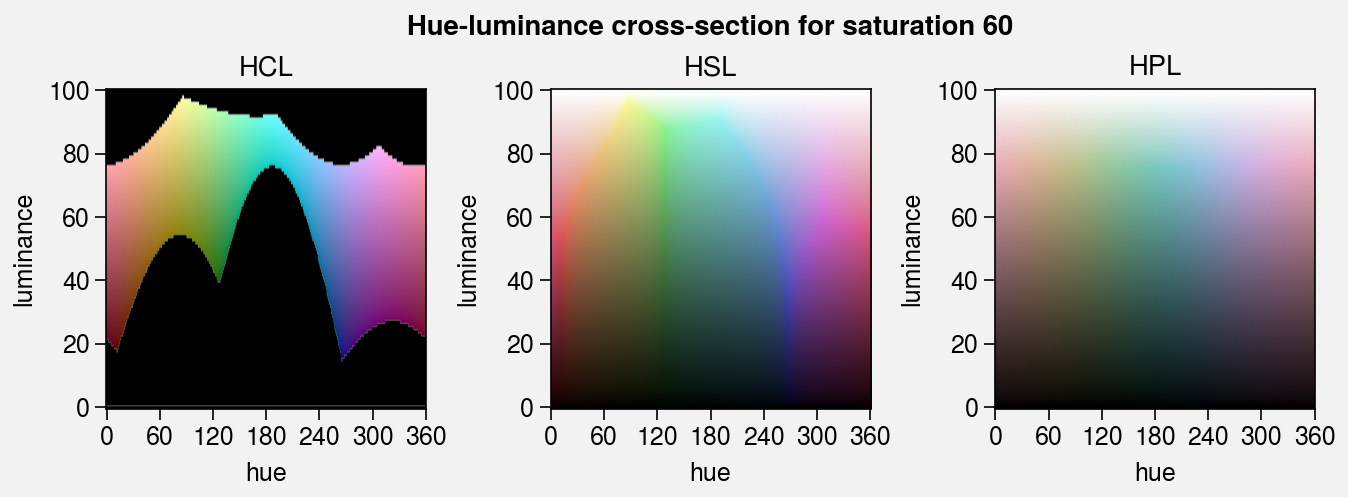
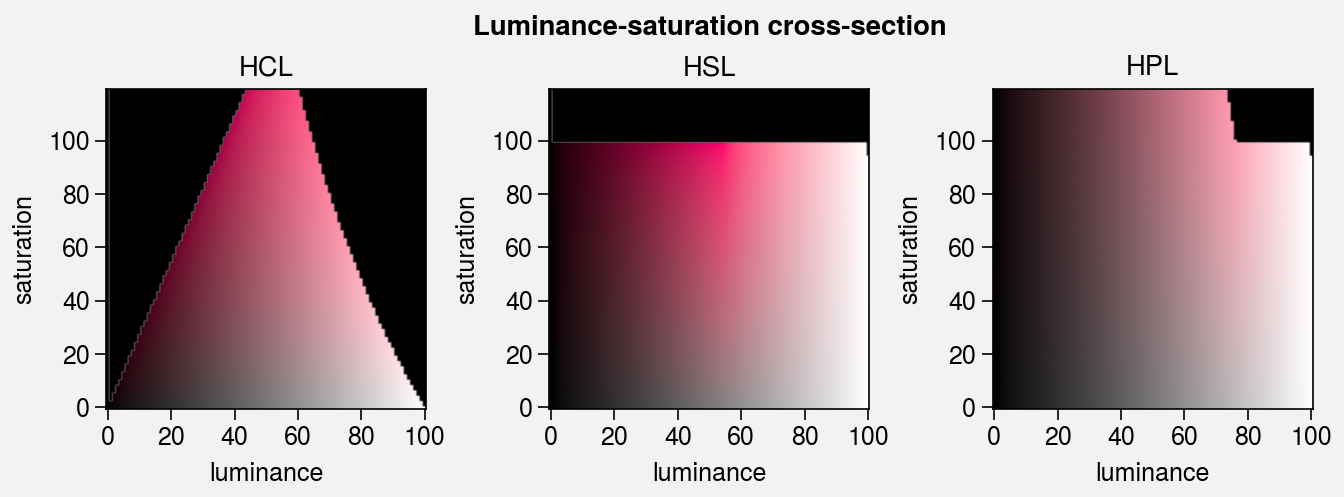
[3]:
# Compare colormaps
import proplot as pplt
for cmaps in (('magma', 'rocket'), ('fire', 'dusk')):
fig, axs = pplt.show_channels(
*cmaps, refwidth=1.5, minhue=-180, maxsat=400, rgb=False
)
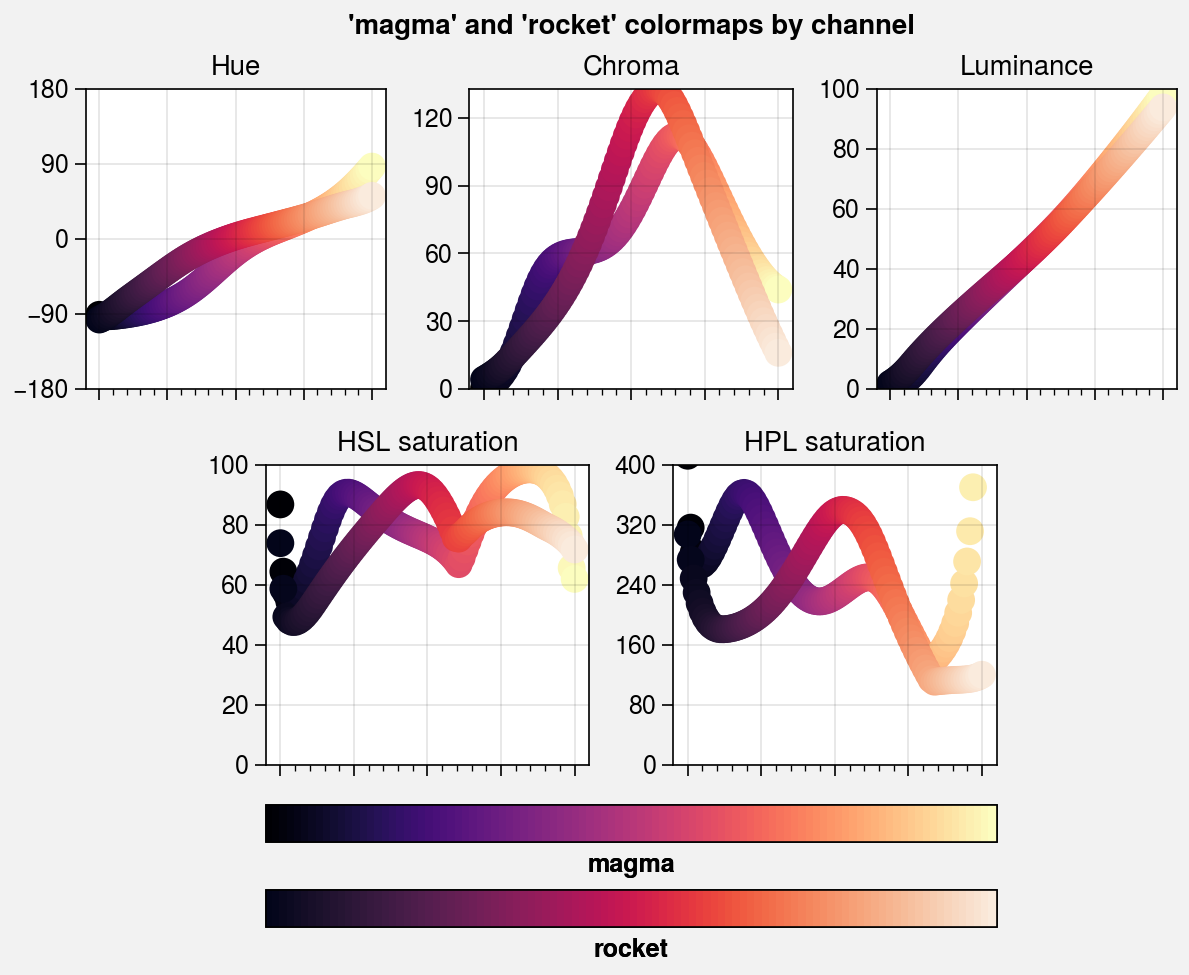
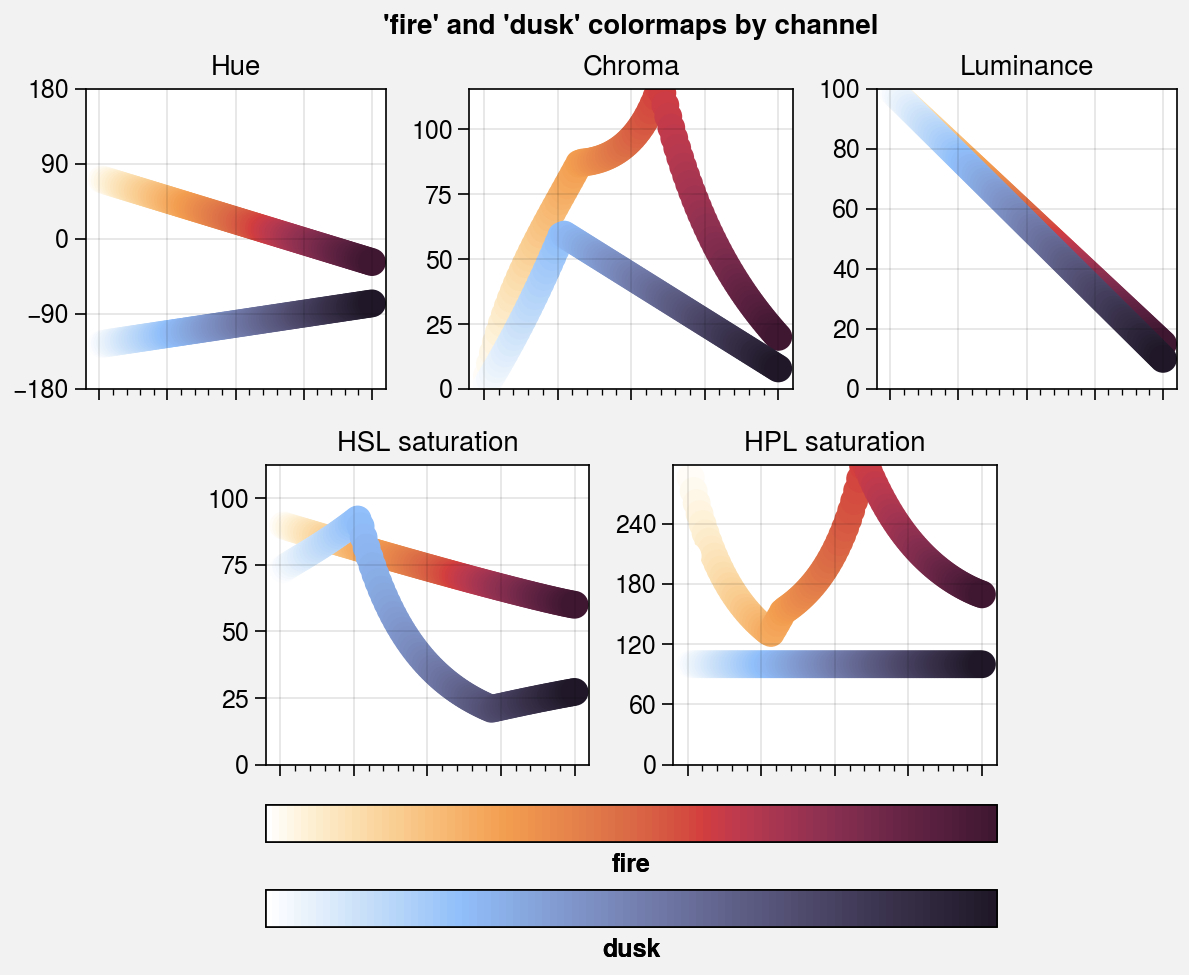
Making new colormaps¶
ProPlot doesn’t just include new colormaps – it provides tools for merging
colormaps, modifying colormaps, making perceptually uniform colormaps from scratch, and saving the results for future use. For
your convenience, most of these features can be accessed via the
Colormap constructor function. Note
that every plotting command that accepts a cmap keyword passes it through this
function (see apply_cmap).
To make PerceptuallyUniformColormaps from scratch, you
have the following three options:
Pass a color name, hex string, or RGB tuple to
Colormap. This builds a monochromatic (single hue) colormap by calling thefrom_colorstatic method. The colormap colors will vary from the specified color to pure white or some shade near white (see thefadekeyword arg).Pass a list of colors to
Colormap. This calls thefrom_liststatic method, which linearly interpolates between each color in hue, saturation, and luminance.Pass a dictionary to
Colormap. This calls thefrom_hslstatic method, which draws lines between channel values specified by the keyword argumentshue,saturation, andluminance. The values can be numbers, color strings, or lists thereof. Numbers indicate the channel value. For color strings, the channel value is inferred from the specified color. You can end any color string with'+N'or'-N'to offset the channel value by the numberN.
In the below example, we use all of these methods to make brand new
PerceptuallyUniformColormaps in the 'hsl' and
'hpl' colorspaces.
[4]:
import proplot as pplt
import numpy as np
state = np.random.RandomState(51423)
data = state.rand(30, 30).cumsum(axis=1)
# Initialize figure
fig, axs = pplt.subplots(ncols=2, nrows=2, refwidth=2, span=0)
axs.format(
xticklabels='none',
yticklabels='none',
suptitle='Making PerceptuallyUniformColormaps'
)
# Colormap from a color
# The trailing '_r' makes the colormap go dark-to-light instead of light-to-dark
cmap1 = pplt.Colormap('prussian blue_r', l=100, name='Pacific', space='hpl')
ax = axs[0]
ax.format(title='From single named color')
m = ax.contourf(data, cmap=cmap1)
ax.colorbar(m, loc='b', ticks='none', label=cmap1.name)
# Colormap from lists
cmap2 = pplt.Colormap(('maroon', 'light tan'), name='Heatwave')
ax = axs[1]
ax.format(title='From list of colors')
m = ax.contourf(data, cmap=cmap2)
ax.colorbar(m, loc='b', ticks='none', label=cmap2.name)
# Sequential colormap from channel values
cmap3 = pplt.Colormap(
h=('red', 'red-720'), s=(80, 20), l=(20, 100), space='hpl', name='CubeHelix'
)
ax = axs[2]
ax.format(title='Sequential from channel values')
m = ax.contourf(data, cmap=cmap3)
ax.colorbar(m, loc='b', ticks='none', label=cmap3.name)
# Cyclic colormap from channel values
cmap4 = pplt.Colormap(
h=(0, 360), c=50, l=70, space='hcl', cyclic=True, name='Spectrum'
)
ax = axs[3]
ax.format(title='Cyclic from channel values')
m = ax.contourf(data, cmap=cmap4)
ax.colorbar(m, loc='b', ticks='none', label=cmap4.name)
# Display the channels
fig, axs = pplt.show_channels(cmap1, cmap2, refwidth=1.5, rgb=False)
fig, axs = pplt.show_channels(cmap3, cmap4, refwidth=1.5, rgb=False)
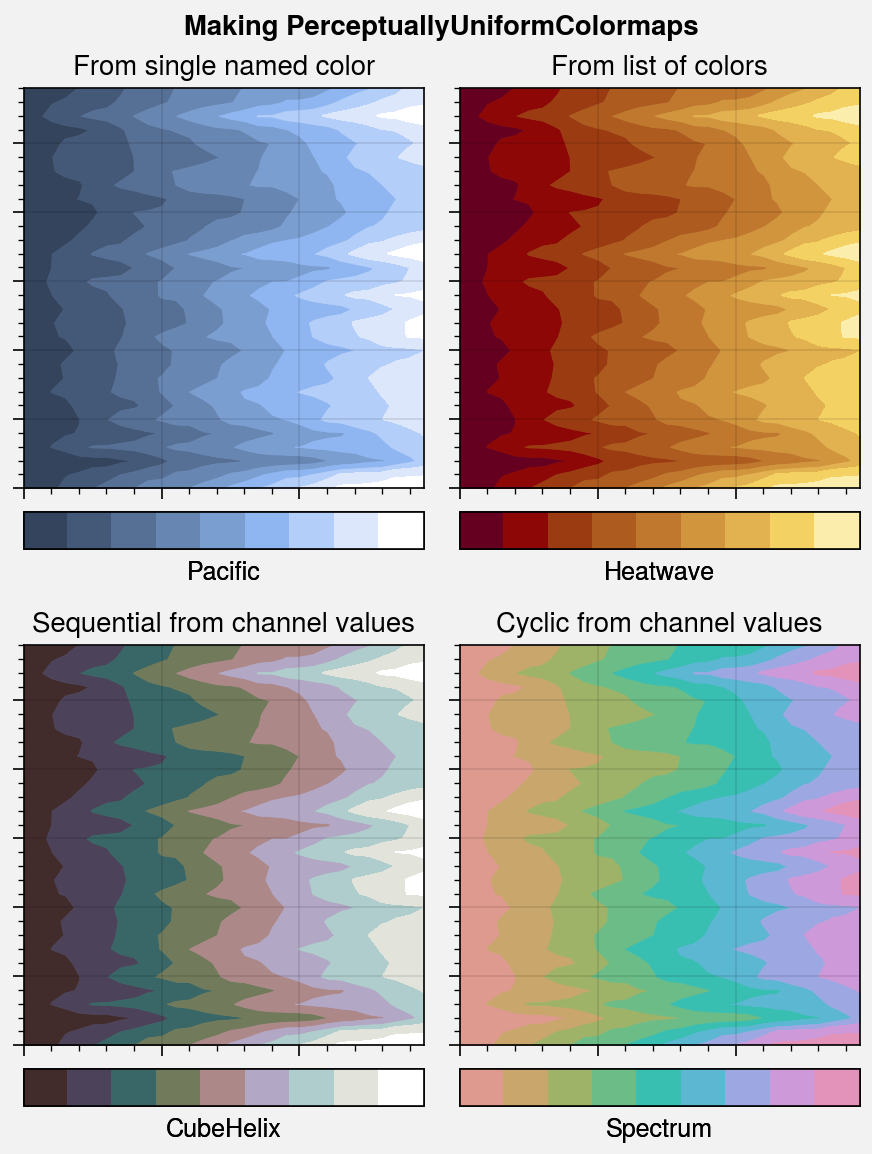
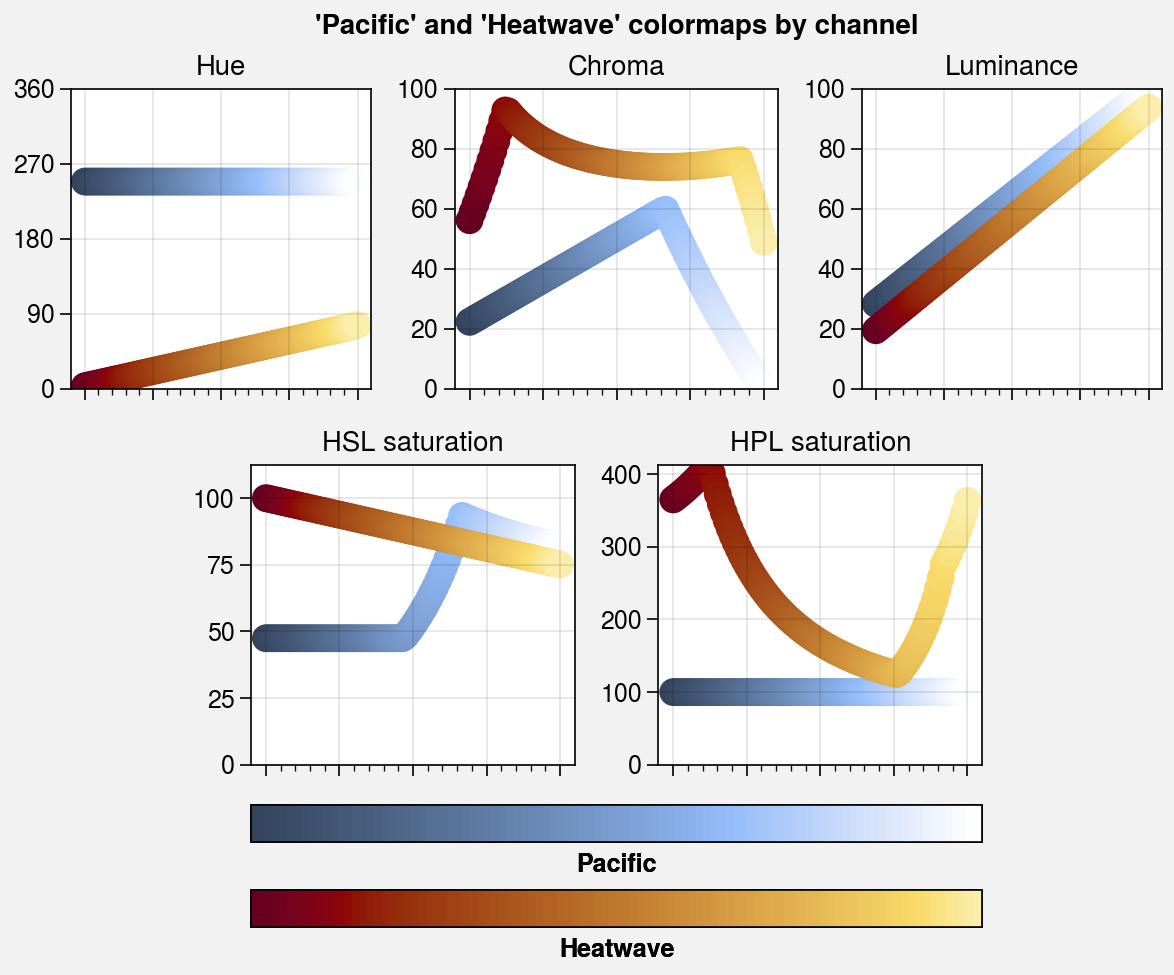
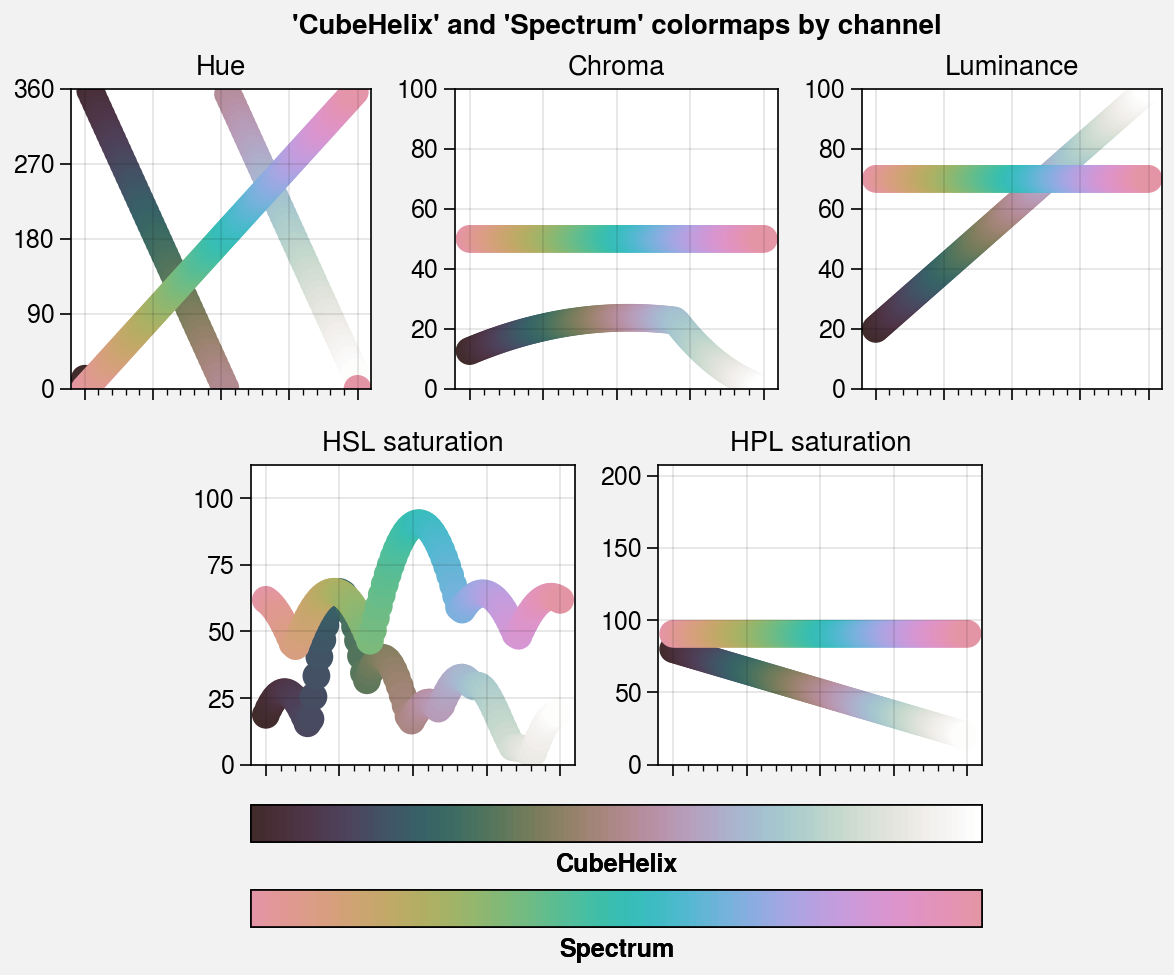
Merging colormaps¶
To merge colormaps, simply pass multiple positional arguments to the
Colormap constructor. This calls the
append method. Each positional
argument can be a colormap name, a colormap instance, or a
special argument that generates a new colormap
on-the-fly. This lets you create new diverging colormaps and segmented
SciVisColor style colormaps
right inside ProPlot. Segmented colormaps are often desirable for complex
datasets with complex statistical distributions.
In the below example, we create a new divering colormap and reconstruct the
colormap from this SciVisColor example.
We also save the results for future use by passing save=True to
Colormap.
[5]:
import proplot as pplt
import numpy as np
state = np.random.RandomState(51423)
data = state.rand(30, 30).cumsum(axis=1)
# Generate figure
fig, axs = pplt.subplots([[0, 1, 1, 0], [2, 2, 3, 3]], refwidth=2.4, span=False)
axs.format(
xlabel='xlabel', ylabel='ylabel',
suptitle='Merging colormaps'
)
# Diverging colormap example
title1 = 'Diverging from two sequential maps'
cmap1 = pplt.Colormap('Blues4_r', 'Reds3', name='Diverging', save=True)
# SciVisColor examples
title2 = 'SciVisColor example with equal ratios'
cmap2 = pplt.Colormap(
'Greens1_r', 'Oranges1', 'Blues1_r', 'Blues6',
name='SciVisColorEven', save=True
)
title3 = 'SciVisColor example'
cmap3 = pplt.Colormap(
'Greens1_r', 'Oranges1', 'Blues1_r', 'Blues6',
ratios=(1, 3, 5, 10), name='SciVisColorUneven', save=True
)
# Plot examples
for ax, cmap, title in zip(axs, (cmap1, cmap2, cmap3), (title1, title2, title3)):
m = ax.contourf(data, cmap=cmap, levels=500)
ax.colorbar(m, loc='b', locator='null', label=cmap.name)
ax.format(title=title)
Saved colormap to '/home/docs/.proplot/cmaps/Diverging.json'.
Saved colormap to '/home/docs/.proplot/cmaps/SciVisColorEven.json'.
Saved colormap to '/home/docs/.proplot/cmaps/SciVisColorUneven.json'.
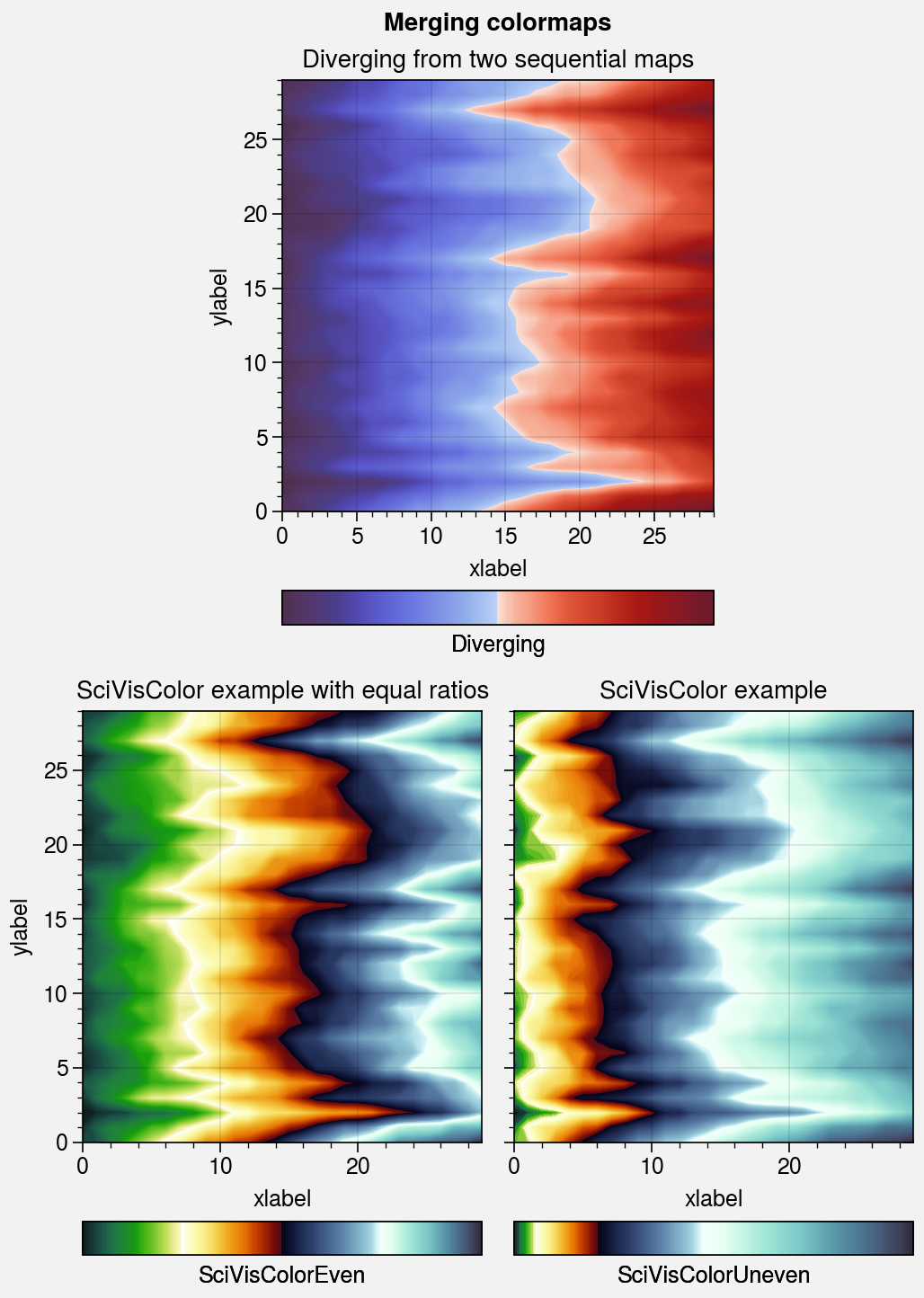
Modifying colormaps¶
ProPlot lets you create modified versions of existing colormaps
using the Colormap constructor and the new
LinearSegmentedColormap and
ListedColormap classes, which are used to replace the
native matplotlib colormap classes. They can be modified in the following
ways:
To remove colors from the left or right ends of a colormap, pass
leftorrighttoColormap. This calls thetruncatemethod, and can be useful when you want to use colormaps as color cycles and need to remove the “white” part so that your lines stand out against the background.To modify the central colors of a diverging colormap, pass
cuttoColormap. This calls thecutmethod, and can be used to create a sharper cutoff between negative and positive values or (whencutis negative) to expand the “neutral” region of the colormap.To rotate a cyclic colormap, pass
shifttoColormap. This calls theshiftedmethod. ProPlot ensures the colors at the ends of “shifted” colormaps are distinct so that levels never blur together.To change the opacity of a colormap or add an opacity gradation, pass
alphatoColormap. This calls theset_alphamethod, and can be useful when layering filled contour or mesh elements.To change the “gamma” of a
PerceptuallyUniformColormap, passgammatoColormap. This calls theset_gammamethod, and controls how the luminance and saturation channels vary between colormap segments.gamma > 1emphasizes high luminance, low saturation colors, whilegamma < 1emphasizes low luminance, high saturation colors. This is similar to the effect of the HCL wizard “power” sliders.
[6]:
import proplot as pplt
import numpy as np
state = np.random.RandomState(51423)
data = state.rand(40, 40).cumsum(axis=0)
# Generate figure
fig, axs = pplt.subplots(
[[0, 1, 1, 0], [2, 2, 3, 3]], refwidth=1.9, span=False,
)
axs.format(
xlabel='y axis', ylabel='x axis',
suptitle='Truncating sequential colormaps',
)
# Cutting left and right
cmap = 'Ice'
for ax, coord in zip(axs, (None, 0.3, 0.7)):
if coord is None:
title, cmap_kw = 'Original', {}
elif coord < 0.5:
title, cmap_kw = f'left={coord}', {'left': coord}
else:
title, cmap_kw = f'right={coord}', {'right': coord}
ax.format(title=title)
ax.contourf(
data, cmap=cmap, cmap_kw=cmap_kw,
colorbar='b', colorbar_kw={'locator': 'null'}
)
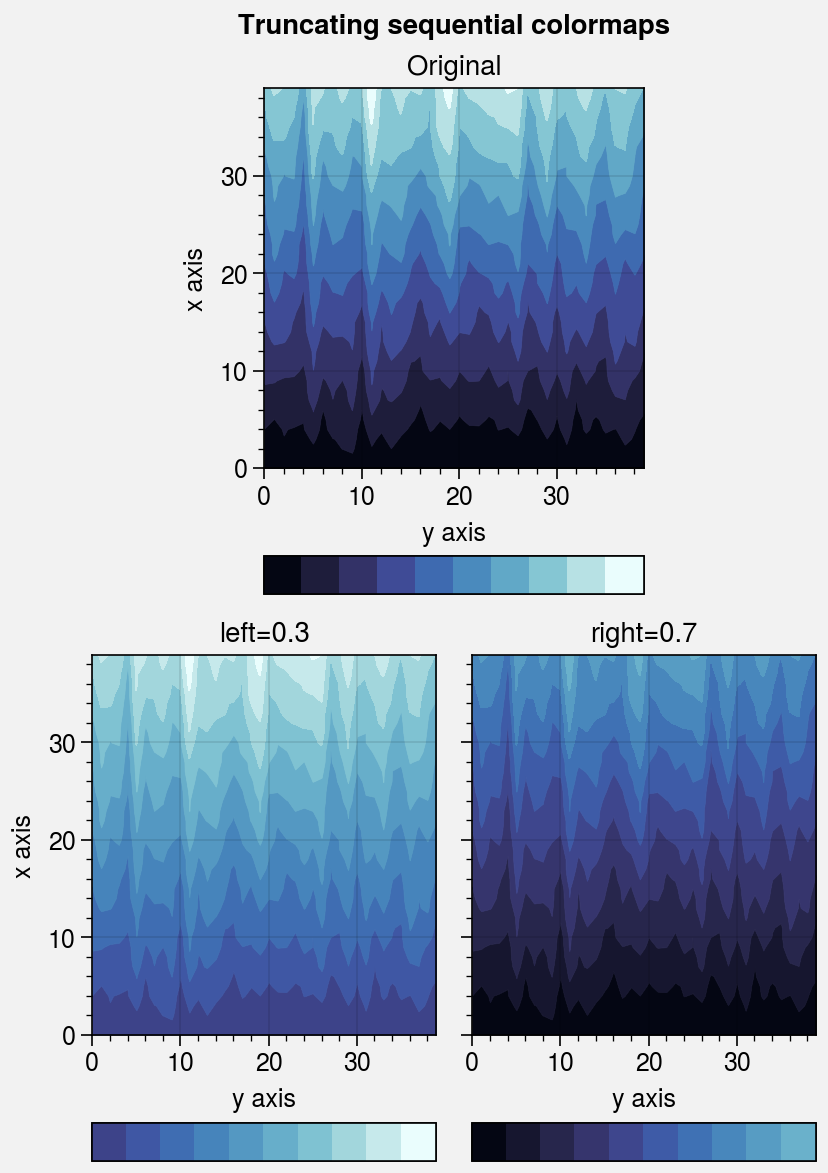
[7]:
import proplot as pplt
import numpy as np
state = np.random.RandomState(51423)
data = (state.rand(40, 40) - 0.5).cumsum(axis=0).cumsum(axis=1)
# Generate figure
fig, axs = pplt.subplots(ncols=2, nrows=2, refwidth=1.7, span=False)
axs.format(
xlabel='x axis', ylabel='y axis', xticklabels='none',
suptitle='Modifying diverging colormaps',
)
# Cutting out central colors
levels = pplt.arange(-10, 10, 2)
for i, (ax, cut) in enumerate(zip(axs, (None, None, 0.2, -0.1))):
levels = pplt.arange(-10, 10, 2)
if i == 1 or i == 3:
levels = pplt.edges(levels)
if i < 2:
title = 'Negative-positive cutoff' if i == 0 else 'Neutral-valued center'
title = f'{title}\nlen(levels) = {len(levels)}'
else:
title = 'Sharper cutoff' if cut > 0 else 'Expanded center'
title = f'{title}\ncut = {cut}'
ax.format(title=title)
m = ax.contourf(
data, cmap='Div', cmap_kw={'cut': cut},
extend='both', levels=levels,
colorbar='b', colorbar_kw={'locator': 'null'},
)
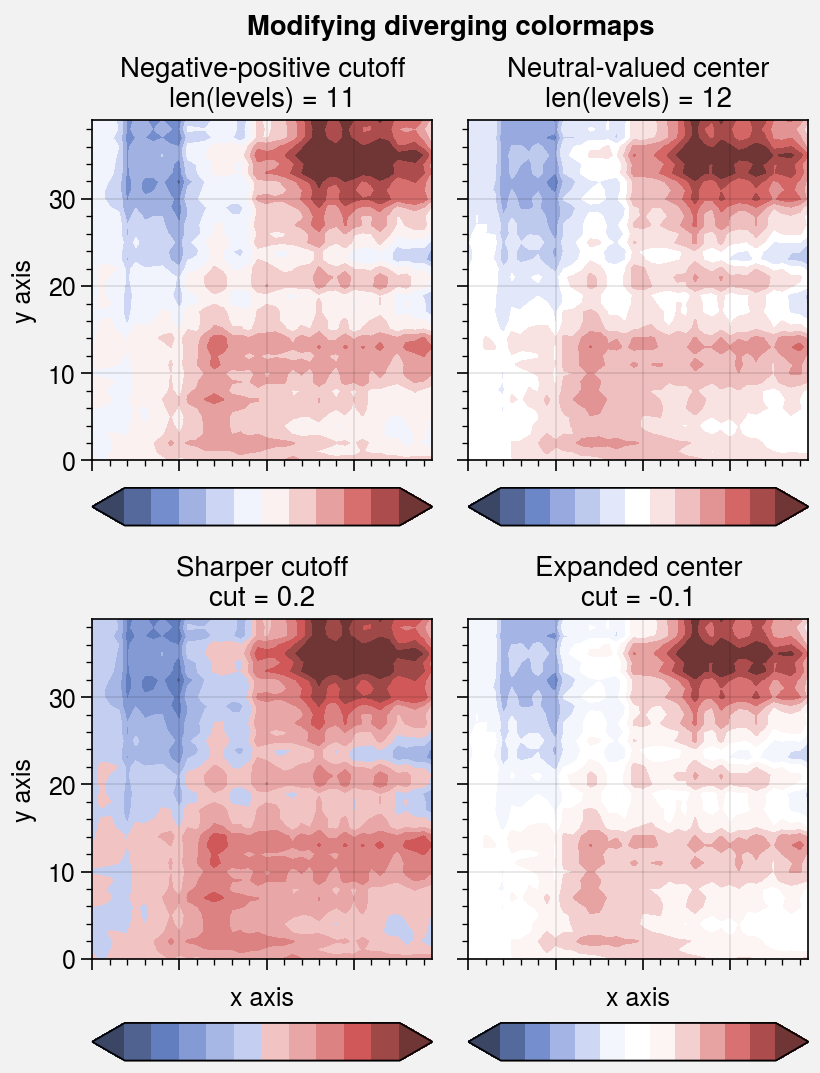
[8]:
import proplot as pplt
import numpy as np
state = np.random.RandomState(51423)
data = (state.rand(50, 50) - 0.48).cumsum(axis=0).cumsum(axis=1) % 30
# Rotating cyclic colormaps
fig, axs = pplt.subplots(ncols=3, refwidth=1.7, span=False)
for ax, shift in zip(axs, (0, 90, 180)):
m = ax.pcolormesh(data, cmap='romaO', cmap_kw={'shift': shift}, levels=12)
ax.format(
xlabel='x axis', ylabel='y axis', title=f'shift = {shift}',
suptitle='Rotating cyclic colormaps'
)
ax.colorbar(m, loc='b', locator='null')
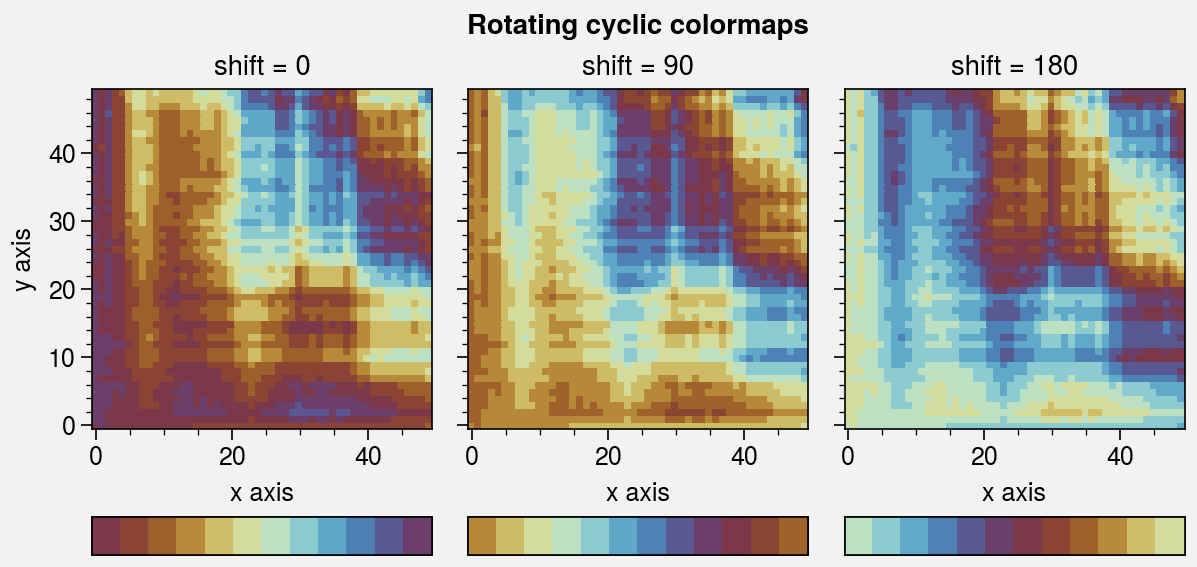
[9]:
import proplot as pplt
import numpy as np
state = np.random.RandomState(51423)
data = state.rand(20, 20).cumsum(axis=1)
# Changing the colormap opacity
fig, axs = pplt.subplots(ncols=3, refwidth=1.7, span=False)
for ax, alpha in zip(axs, (1.0, 0.5, 0.0)):
alpha = (alpha, 1.0)
cmap = pplt.Colormap('batlow_r', alpha=alpha)
m = ax.imshow(data, cmap=cmap, levels=10, extend='both')
ax.colorbar(m, loc='b', locator='none')
ax.format(
title=f'alpha = {alpha}', xlabel='x axis', ylabel='y axis',
suptitle='Adding opacity gradations'
)
/tmp/ipykernel_3035/4264107422.py:12: ProPlotWarning: Using manual alpha-blending for 'batlow_r_copy' colorbar solids.
ax.colorbar(m, loc='b', locator='none')
/tmp/ipykernel_3035/4264107422.py:12: ProPlotWarning: Using manual alpha-blending for 'batlow_r_copy' colorbar solids.
ax.colorbar(m, loc='b', locator='none')
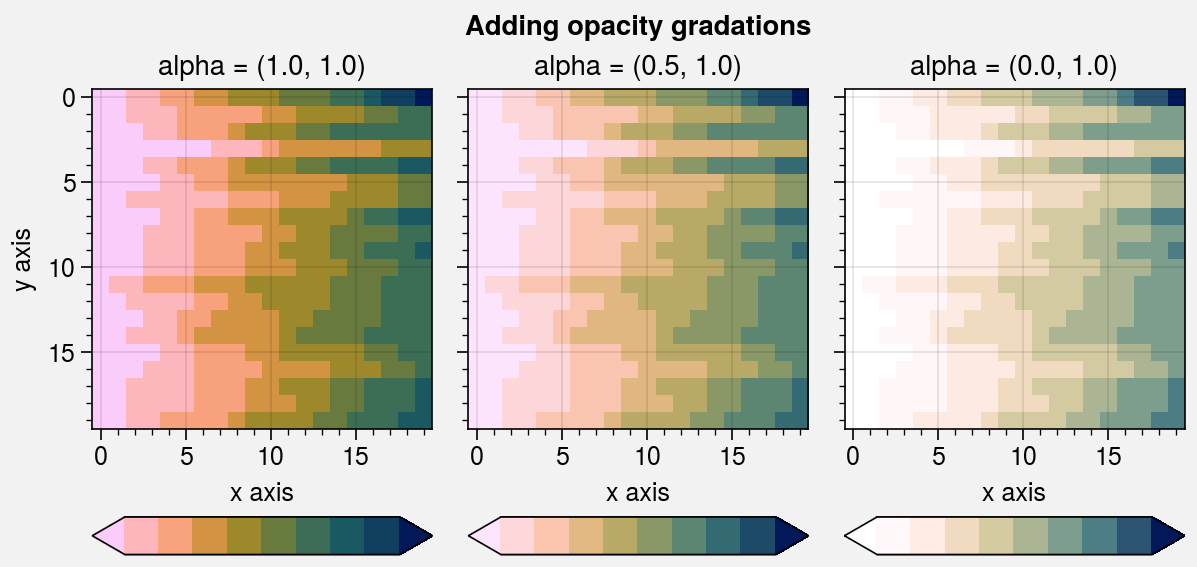
[10]:
import proplot as pplt
import numpy as np
state = np.random.RandomState(51423)
data = state.rand(20, 20).cumsum(axis=1)
# Changing the colormap gamma
fig, axs = pplt.subplots(ncols=3, refwidth=1.7, span=False)
for ax, gamma in zip(axs, (0.7, 1.0, 1.4)):
cmap = pplt.Colormap('boreal', gamma=gamma)
m = ax.pcolormesh(data, cmap=cmap, levels=10, extend='both')
ax.colorbar(m, loc='b', locator='none')
ax.format(
title=f'gamma = {gamma}', xlabel='x axis', ylabel='y axis',
suptitle='Changing the PerceptuallyUniformColormap gamma'
)
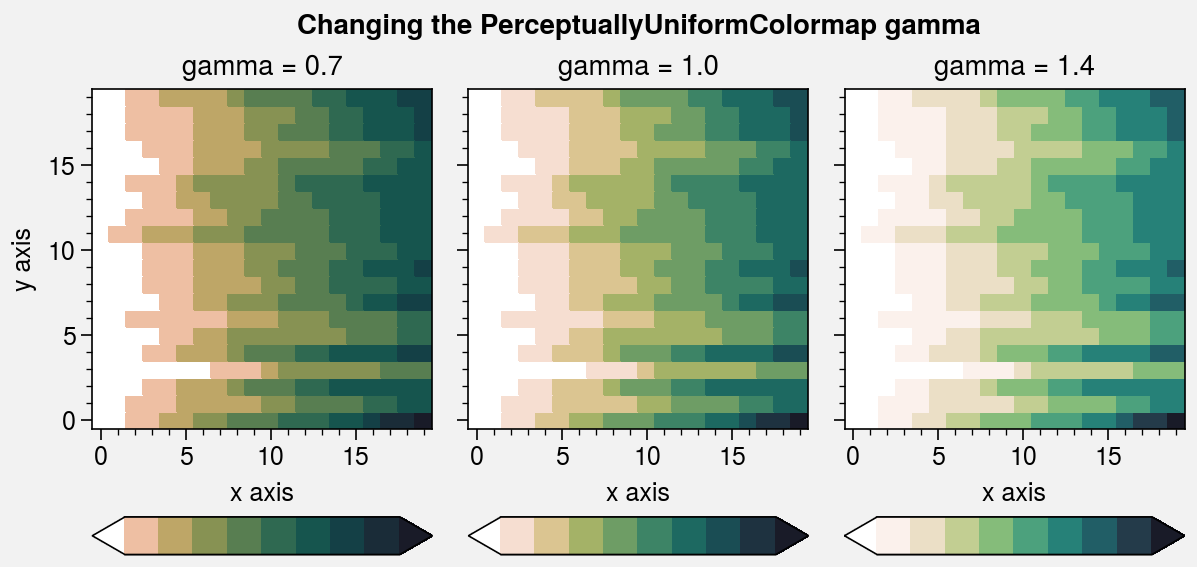
Downloading colormaps¶
There are plenty of online interactive tools for generating perceptually uniform colormaps, including Chroma.js, HCLWizard, HCL picker, the CCC-tool, and SciVisColor.
To add colormaps downloaded from any of these sources, save the colormap
data to a file in your ~/.proplot/cmaps folder and call
register_cmaps (or restart your python session), or use
from_file. The file name is used
as the registered colormap name. See
from_file for a table of valid
file extensions.